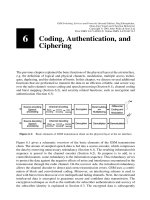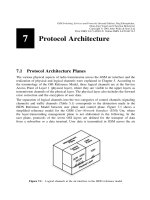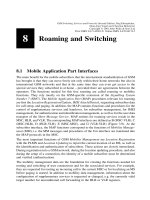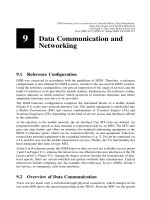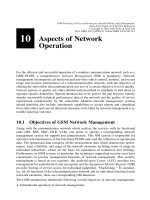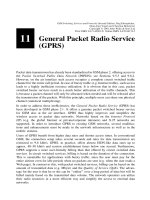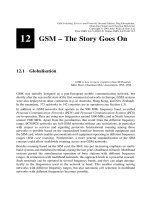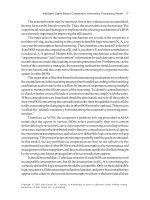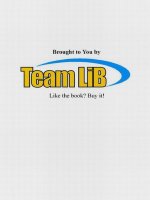The common management information services and protocols for the internet (CMOT and CMIP)
Bạn đang xem bản rút gọn của tài liệu. Xem và tải ngay bản đầy đủ của tài liệu tại đây (18.45 KB, 15 trang )
Network Working Working Group U. Warrier
Request for Comments: 1189 Netlabs
Obsoletes: RFC 1095 L. Besaw
Hewlett-Packard
L. LaBarre
The Mitre Corporation
B. Handspicker
Digital Equipment Corporation
October 1990
The Common Management Information Services
and Protocols for the Internet
(CMOT and CMIP)
Status of this Memo
This memo defines a network management architecture that uses the
International Organization for Standardization’s (ISO) Common
Management Information Services/Common Management Information
Protocol (CMIS/CMIP) in the Internet. This RFC specifies an IAB
standards track protocol for the Internet community, and requests
discussion and suggestions for improvements. Please refer to the
current edition of the "IAB Official Protocol Standards" for the
standardization state and status of this protocol.
Distribution of this memo is unlimited.
Table of Contents
1. Overview 2
2. Introduction 3
3. Protocol Overview 4
3.1. The CMOT Protocol Suite 5
3.2. The CMIP Protocol Suite 6
3.3. Conformance Requirements 6
4. Common Management Information Service Element 7
4.1. Association Policies 7
4.2. CMIS Services 9
4.2.1 General Agreements on Users of CMIS 9
4.2.2 Specific Agreements on Users of CMIS 10
4.3. CMIP Agreements 10
5. Services Required by CMIP 10
6. Acknowledgements 11
7. References 11
8. Security Considerations 14
9. Authors’ Addresses 14
Warrier, Besaw, LaBarre & Handspicker [Page 1]
RFC 1189 CMOT and CMIP October 1990
1. Overview
This memo is a revision of RFC 1095 - "The Common Management
Information Services and Protocol over TCP/IP" [27]. It defines a
network management architecture that uses the International
Organization for Standardization’s (ISO) Common Management
Information Services/Common Management Information Protocol
(CMIS/CMIP) in the Internet. This architecture provides a means by
which control and monitoring information can be exchanged between a
manager and a remote network element. In particular, this memo
defines the means for implementing the International Standard (IS)
version of CMIS/CMIP on top of both IP-based and OSI-based Internet
transport protocols for the purpose of carrying management
information defined in the Internet-standard management information
base. Together with the relevant ISO standards and the companion
RFCs that describe the initial structure of management information
and management information base, these documents provide the basis
for a comprehensive architecture and system for managing both IP-
based and OSI-based internets, and in particular the Internet.
In creating this revision of RFC 1095, the following technical and
editorial changes were made:
1) The tutorial section on OSI Management included in RFC 1095
has been removed from this document. After some revisions,
the tutorial material may be published as another RFC.
2) The sections in RFC 1095 which discussed the semantics of how
to interpret requests in the context of Internet MIBs has been
removed from this protocol document. This topic is now
discussed in the OIM-MIB-II draft document. This protocol
should be useable with MIB-I or MIB-II. But, it will also be
able to exploit the new features of the OIM-MIB-II.
3) This document is based on the final International Standards
for CMIS/CMIP (ISO 9595/9596) rather than the Draft
International Standards.
4) Many of the original agreements defined in RFC 1095 have been
accepted and included in the OIW NMSIG implementers agreements.
Rather than duplicating these agreements, they have been removed
from this memo. This document should be read in conjunction
with ISO 9595/9596 (CMIS/CMIP) and the OIW Stable Agreements
document.
5) The Association Negotiation describe in RFC 1095 has been
changed to align with current international and national
agreements. But, it has retained backwards compatibility with
Warrier, Besaw, LaBarre & Handspicker [Page 2]
RFC 1189 CMOT and CMIP October 1990
the assignment of an Application Context Name which is identical
to the Application Context Name specified in RFC 1095.
2. Introduction
This memo is the output of the OSI Internet Management Working Group
of the Internet Engineering Task Force (IETF). As directed by the
Internet Activites Board (IAB) in RFC 1052, it addresses the need for
a long-term network management system based on ISO CMIS/CMIP. This
memo contains a set of protocol agreements for implementing a network
management system based on these ISO Management standards. Now that
CMIS/CMIP has been voted an International Standard (IS), it has
become a stable basis for product development. This profile
specifies how to apply CMIP to management of both IP-based and OSI-
based Internet networks. Network management using ISO CMIP to manage
IP-based networks will be refered to as "CMIP Over TCP/IP" (CMOT).
Network management using ISO CMIP to manage OSI-based networks will
be refered to as "CMIP". This memo specifies the protocol agreements
necessary to implement CMIP and accompanying ISO protocols over OSI,
TCP and UDP transport protocols.
This memo must be read in conjunction with ISO and Internet documents
defining specific protocol standards. Documents defining the
following ISO standards are required for the implementor: Abstract
Syntax Notation One (ASN.1) [5, 6], Association Control (ACSE) [7,
8], Remote Operations (ROSE) [9, 10], Common Management Information
Services (CMIS) [11] and Common Management Information Protocol
(CMIP) [12] with their addenda [32-35]. The specification of a
lightweight presentation layer protocol is required for use with the
CMOT section of this profile (see RFC 1085 [13]). The SMI (see RFC
1065 [2]), the MIB-I (see RFC 1066 [3]), the MIB-II (see RFC 1156
[28]), and the OIM-MIB-II (see [29]) are used with this management
system.
This memo is divided into sections for each of the protocols for
which implementors’ agreements are needed: CMISE, ACSE, ROSE, and,
for CMOT, the lightweight presentation protocol. The protocol
profile defined in this memo draws on the technical work of the OSI
Network Management Forum [14] and the Network Management Special
Interest Group (NMSIG) of the National Institute of Standards and
Technology (NIST) (formerly the National Bureau of Standards) [30].
Wherever possible, an attempt has been made to either directly
reference or remain consistent with the protocol agreements reached
by these groups.
Warrier, Besaw, LaBarre & Handspicker [Page 3]
RFC 1189 CMOT and CMIP October 1990
3. Protocol Overview
This part of the document is a specification of the protocols of the
OIM architecture. Contained herein are the agreements required to
implement interoperable network management systems using these
protocols. The protocol suite defined by these implementors’
agreements will facilitate communication between equipment of
different vendors, suppliers, and networks. This will allow the
emergence of powerful multivendor network management based on ISO
models and protocols.
The choice of a set of protocol standards together with further
agreements needed to implement those standards is commonly referred
to as a "profile." The selection policy for this profile is to use
existing standards from the international standards community (ISO
and CCITT) and the Internet community. Existing ISO standards and
draft standards in the area of OSI network management form the basis
of this profile. Other ISO application layer standards (ROSE and
ACSE) are used to support the ISO management protocol (CMIP). To
ensure interoperability, certain choices and restrictions are made
here concerning various options and parameters provided by these
standards. Internet standards are used to provide the underlying
network transport. These agreements provide a precise statement of
the implementation choices made for implementing ISO network
management standards in IP-based and OSI-based internets.
In addition to the OIM working group, there are at least two other
bodies actively engaged in defining profiles for interoperable OSI
network management: the OSI Implementors Workshop (OIW) and the OSI
Network Management Forum. Both of these groups are similar to the
OIM working group in that they are each defining profiles for using
ISO standards for network management. Both differ in that they are
specifying the use only of underlying ISO protocols, while the OIM
working group is concerned with using OSI management in both OSI and
TCP/IP networks. In the interest of greater future compatibility,
the OIM working group has attempted to make this profile conform as
closely as possible to the ongoing work of these two bodies.
This section will describe the CMOT Protocol Suite, the CMIP Protocol
Suite and Conformance Requirements common to both CMOT and CMIP.
Later sections will specify the implementers agreements for specific
layer protocols that comprise the CMOT and CMIP Protocol Suites.
Warrier, Besaw, LaBarre & Handspicker [Page 4]
RFC 1189 CMOT and CMIP October 1990
3.1. The CMOT Protocol Suite
The following seven protocols compose the CMOT protocol suite: ISO
ACSE, ISO DIS ROSE, ISO CMIP, the lightweight presentation protocol
(LPP), UDP, TCP, and IP. The relation of these protocols to each
other is briefly summarized in Figure 2.
+ +
Management Application Processes
+ +
+ +
CMISE
ISO 9595/9596
+ +
+ + + +
ACSE ROSE
ISO IS 8649/8650 ISO DIS 9072-1/2
+ + + +
+ +
Lightweight Presentation Protocol (LPP)
RFC 1085
+ +
+ + + +
TCP UDP
RFC 793 RFC 768
+ + + +
+ +
IP
RFC 791
+ +
Figure 2. The CMOT Protocol Suite
Warrier, Besaw, LaBarre & Handspicker [Page 5]
RFC 1189 CMOT and CMIP October 1990
3.2. The CMIP Protocol Suite
The following six protocols compose the CMIP protocol suite: ISO
ACSE, ISO DIS ROSE, ISO CMIP, ISO Presentation, ISO Session and ISO
Transport. The relation of these protocols to each other is briefly
summarized in Figure 3.
+ +
Management Application Processes
+ +
+ +
CMISE
ISO 9595/9596
+ +
+ + + +
ACSE ROSE
ISO 8649/8650 ISO DIS 9072-1/2
+ + + +
+ +
ISO Presentation
ISO
+ +
+ +
ISO Session
ISO
+ +
+ +
ISO Transport
ISO
+ +
Figure 3. The CMIP Protocol Suite
3.3. Conformance Requirements
A CMOT-conformant system must implement the following protocols:
ACSE, ROSE, CMIP, LPP, and IP. A CMOT-conformant system must support
the use of the LPP over either UDP or TCP. The use of the LPP over
both UDP and TCP on the same system may be supported.
A CMIP-conformant system must implement the following protocols:
ACSE, ROSE, CMIP, ISO Presentation, ISO Session and ISO Transport.
Warrier, Besaw, LaBarre & Handspicker [Page 6]
RFC 1189 CMOT and CMIP October 1990
4. Common Management Information Service Element
The Common Management Information Service Element (CMISE) is
specified in two ISO documents. The service definition for the
Common Management Information Service (CMIS) is given in ISO 9595
[11]. The protocol specification for the Common Management
Information Protocol (CMIP) is found in ISO 9596 [12]. In addition,
the addenda for add/remove support in M-SET [32, 34] must be
supported for both CMOT and CMIP. The addenda for M-CANCEL-GET [33,
35] may be supported by an implementation, but it’s use is negotiated
as part of association negotiation.
4.1. Association Policies
The following ACSE services are required by CMISE: A-ASSOCIATE, A-
RELEASE, A-ABORT, and A-P-ABORT. The rest of the CMIP protocol uses
the RO-INVOKE, RO-RESULT, RO-ERROR, and RO-REJECT services of ROSE.
There are four types of association that may be negotiated between
managing and managed systems. These types are:
Event M-EVENT-REPORTs may be sent by the
managed system; no other CMIP PDUs
are allowed
Event/Monitor same as Event type except that, in
addition, the managing system may
also issue M-GET requests and
receive M-GET responses over the
association
Monitor/Control managing system may issue M-GET,
M-SET, M-CREATE, M-DELETE and
M-ACTION requests over the
association; no event reporting is
allowed
Full Mgr/Agent all functions must be supported
A conformant system must support at least one of these Association
types. Note that a system may play both managing and managed system
roles, but not on the same association.
The negotiation process uses the A-ASSOCIATE and A-RELEASE services.
Application Context Name is used to determine the requestor’s "role"
in an association (as managing or managed system) and to determine
the type of the association.
Warrier, Besaw, LaBarre & Handspicker [Page 7]
RFC 1189 CMOT and CMIP October 1990
The following values for Application Context Name are registered for
for CMOT and CMIP:
{iso(1) identified-organization(3) dod(6)
internet(1) mgmt(2) mib(1) oim(9) acn(1)
cmot1095(1)}
(for backwards compatible negotiation with RFC 1095 CMOT
implementations)
{iso(1) identified-organization(3) dod(6)
internet(1) mgmt(2) mib(1) oim(9) acn(1)
manager-event-association(2)}
{iso(1) identified-organization(3) dod(6)
internet(1) mgmt(2) mib(1) oim(9) acn(1)
manager-event-monitor-association(3)}
{iso(1) identified-organization(3) dod(6)
internet(1) mgmt(2) mib(1) oim(9) acn(1)
manager-monitor-control-association(4)}
{iso(1) identified-organization(3) dod(6)
internet(1) mgmt(2) mib(1) oim(9) acn(1)
manager-full-association(5)}
{iso(1) identified-organization(3) dod(6)
internet(1) mgmt(2) mib(1) oim(9) acn(1)
agent-event-association(6)}
The following negotiation rules are to be used:
1. A managed system may only request an Event
association and, in fact, must create an Event
association if it has an event to report and no
suitable association already exists.
2. Managing systems may request any association type.
3. An association is created by the requesting system
issuing an A-ASSOCIATE request with the
requestor’s AE-TITLE and the desired application
context. The responding system then returns
either 1) an A-ASSOCIATE response with the
requestor’s AE-TITLE and the application context
which it wishes to accept or 2) an A-ASSOCIATE
response rejecting the association.
Warrier, Besaw, LaBarre & Handspicker [Page 8]
RFC 1189 CMOT and CMIP October 1990
4. Managed systems may negotiate "downward" from
Full to Monitor/Control, Event/Monitor or Event by
returning the new application context in the
A-ASSOCIATE response to the managing system during
the association creation process. In the same
fashion, managed systems may negotiate from
Event/Monitor to Event.
5. When a managing system receives an application
context in an A-ASSOCIATE response that differs
from the context sent in an A-ASSOCIATE request it
may either proceed with the new context or refuse
the new context by issuing an A-RELEASE request.
A-RELEASE is used when the requestor does not agree with the new
context. A-ABORT is used for invalid negotiation. If A-ABORT were
to be used to terminate an association, there exists the potential
for loss of information, such as pending events or confirmations.
A-ABORT must be used, however, when a protocol violation occurs or
where an association is not yet established.
4.2. CMIS Services
4.2.1 General Agreements on Users of CMIS
The general agreements on users of CMIS shall be as specified in the
OIW Stable Agreements [30] section 18.6.2.
The following additional agreements are specified.
o A system need only implement the services and service
primitives required for the association types (section 4.1)
that it supports.
o Current/Event times shall be fields shall use 1 millisecond
granularity. If the system generating the PDU does not have
the current time, yet does have the time since last boot, then
GeneralizedTime can be used to encode this information. The
time since last boot will be added to the base time "0001
Jan 1 00:00:00.00" using the Gregorian calendar algorithm.
(In the Gregorian calendar, all years have 365 days except
those divisible by 4 and not by 400, which have 366.) The use
of the year 1 as the base year will prevent any confusion
with current time.
If no meaningful time is available, then the year 0 shall be
used in GeneralizedTime to indicate this fact.
Warrier, Besaw, LaBarre & Handspicker [Page 9]
RFC 1189 CMOT and CMIP October 1990
4.2.2 Specific Agreements on Users of CMIS
The specific agreements on users of CMIS shall be as specified in the
OIW Stable Agreements [30] section 18.6.3.
The following additional agreements are specified:
o Event time shall be mandatory for all events.
o Both the "managed Object Class" and "managed Object
Instance" parameters must be present in the following CMIS
Service Response/Confirmation primitives: the
M-EVENT-REPORT Confirmed, the M-GET, the M-SET, the
M-ACTION, the M-CREATE, and the M-DELETE.
4.3. CMIP Agreements
The CMIS and CMIP implementers agreements documented in the OIW
Stable Implementers Agreements [30] plus those mandated by the CMIP
standard will be used for both CMOT and CMIP. In addition to these
implementers agreements, the following specific agreements must be
observed:
o An implementation is required to support all filter items
except subsetOf, supersetOf, nonNullSetIntersection, and
substrings.
o The "managedObjectInstance" field must be present in the
ProcessingFailure Error PDU. The "managedObjectClass"
field must be present in the NoSuchArgument Error PDU.
[Temporary Note: The CMIS/P implementers agreements have reach a
fairly stable status in the OIW working agreements document. It is
expected that the CMIS/P agreements (18.6.2 and 18.6.3) will be
recommended to be moved into the stable agreements document during
either the June 1990 meetings. Reference [30] points to the presumed
June 1990 updated version of the stable agreements document.]
5. Services Required by CMIP
The services required by CMIP shall be as specified in the OIW Stable
Implementors Agreements [30] section 18.6.5.
The following additional agreements are specified:
o ASCE Requirements: Application contexts shall be as defined
in section 4.1 of these agreements. The values and defaults
Warrier, Besaw, LaBarre & Handspicker [Page 10]
RFC 1189 CMOT and CMIP October 1990
of parameters to the ACSE parameters given to the presentation
service are specified in RFC 1085 [13] for CMOT and in the NIST
Stable Implementers Agreements [30] for CMIP.
o Presentation Requirements: CMOT implementations shall be
supported by the Lightweight Presentation Protocol (LPP)
[13]. The LPP may use either TCP or UDP. When UDP is used,
an implementation need not accept LPP PDUs whose length
exceeds 484 octets.
o Session Requirements: CMOT implementations will not
require the session protocol.
6. Acknowledgements
This RFC is the result of the work of many people. The following
members of the IETF OSI Internet Management and preceding Netman
working groups made important contributions:
Amatzia Ben-Artzi, Synoptics
Asheem Chandna, AT&T Bell Laboratories
Ken Chapman, Digital Equipment Corporation
Anthony Chung, Sytek
George Cohn, Ungermann-Bass
Gabriele Cressman, Sun Microsystems
Tom Halcin, Hewlett-Packard
Pranati Kapadia, Hewlett-Packard
Lee LaBarre, The MITRE Corporation (co-chair)
Dave Mackie, 3Com
Keith McCloghrie, Hughes/InterLan
Jim Robertson, 3Com
Milt Roselinsky, CMC
Marshall Rose, PSI
John Scott, Data General
Lou Steinberg, IBM
7. References
[1] Cerf, V., "IAB Recommendations for the Development of Internet
Network Management Standards", RFC 1052, IAB, April 1988.
[2] Rose, M., and K. McCloghrie, "Structure and Identification of
Management Information for TCP/IP-based internets", RFC 1065,
TWG, August 1988.
[3] McCloghrie, K., and M. Rose, "Management Information Base for
Network Management of TCP/IP-based internets", RFC 1066, TWG,
August 1988.
Warrier, Besaw, LaBarre & Handspicker [Page 11]
RFC 1189 CMOT and CMIP October 1990
[4] Case, J., M. Fedor, M. Schoffstall, and J. Davin, "A Simple
Network Management Protocol (SNMP)", RFC 1098, (Obsoletes RFC
1067), University of Tennessee at Knoxville, NYSERNet, Inc.,
Rensselaer Polytechnic Institute, MIT Laboratory for Computer
Science, April 1989.
[5] ISO 8824: "Information Processing Systems - Open Systems
Interconnection, Specification of Abstract Syntax Notation One
(ASN.1)", Geneva, March 1988.
[6] ISO 8825: "Information Processing Systems - Open Systems
Interconnection, Specification of Basic Encoding Rules for
Abstract Notation One (ASN.1)", Geneva, March 1988.
[7] ISO 8649: "Information Processing Systems - Open Systems
Interconnection, Service Definition for Association Control
Service Element".
[8] ISO 8650: "Information Processing Systems - Open Systems
Interconnection, Protocol Specification for Association Control
Service Element".
[9] CCITT Recommendation X.219, Working Document for ISO 9072-1:
"Information processing systems - Text Communication, Remote
Operations: Model, Notation and Service Definition", Gloucester,
November 1987.
[10] CCITT Recommendation X.229, Working Document for ISO 9072-2:
"Information processing systems - Text Communication, Remote
Operations: Protocol Specification", Gloucester, November 1987.
[11] ISO 9595: "Information Processing Systems - Open Systems
Interconnection, Management Information Service Definition - Part
2: Common Management Information Service", 22 December 1988.
[12] ISO 9596: "Information Processing Systems - Open Systems
Interconnection, Management Information Protocol Specification -
Part 2: Common Management Information Protocol", 22 December
1988.
[13] Rose, M., "ISO Presentation Services on top of TCP/IP-based
internets", RFC 1085, TWG, December 1988.
[14] OSI Network Management Forum, "Forum Interoperable Interface
Protocols", September 1988.
[15] ISO DIS 7498-4: "Information Processing Systems - Open Systems
Interconnection, Basic Reference Model - Part 4: OSI Management
Warrier, Besaw, LaBarre & Handspicker [Page 12]
RFC 1189 CMOT and CMIP October 1990
Framework".
[16] ISO/IEC JTC1/SC21/WG4 N571: "Information Processing Systems -
Open Systems Interconnection, Systems Management: Overview",
London, July 1988.
[17] Klerer, S. Mark, "The OSI Management Architecture: An Overview",
IEEE Network Magazine, March 1988.
[18] Ben-Artzi, A., "Network Management for TCP/IP Networks: An
Overview", Internet Engineering Task Force working note, April
1988.
[19] ISO/IEC JTC1/SC21/WG4 N3324: "Information Processing Pystems -
Open Systems Interconnection, Management Information Services -
Structure of Management Information - Part I: Management
Information Model", Sydney, December 1988.
[20] Postel, J., "User Datagram Protocol", RFC 768, USC/Information
Sciences Institute, August 1980.
[21] Postel, J., "Transmission Control Protocol", RFC 793,
USC/Information Sciences Institute, September 1981.
[22] ISO DP 9534: "Information processing systems - Open Systems
Interconnection, Application Layer Structure", 10 March 1987.
[23] Rose, M., and D. Cass, "ISO Transport Services on top of the TCP,
Version: 3", RFC 1006, Northrop Research and Technology Center,
May 1987.
[24] ISO 8822: "Information Processing Systems - Open Systems
Interconnection, Connection Oriented Presentation Service
Definition", June 1987.
[25] Postel, J., "Internet Protocol", RFC 791, USC/Information
Sciences Institute, September 1981.
[26] CCITT Draft Recommendation X.500, ISO 9594/1-8: "The Directory",
Geneva, March 1988.
[27] Warrier, U. and L. Besaw, "The Common Management Information
Services and Protocol over TCP/IP (CMOT)", RFC 1095, Unisys
Corporation, Hewlett-Packard, April 1989.
[28] McCloghrie, K., and M. Rose, "Management Information Base for
Network Management of TCP/IP-based internets", RFC 1156, Hughes
LAN Systems, Performance Systems International, May 1990.
Warrier, Besaw, LaBarre & Handspicker [Page 13]
RFC 1189 CMOT and CMIP October 1990
[29] LaBarre, L., "OIM MIB-II", working note, December 1989.
[30] NIST NMSIG, "NIST Stable Implementers Agreements", NIST Special
Publication 500-162, as ammended by June 1990.
[31] NIST NMSIG, "NIST Working Implementers Agreements", December
1989.
[32] ISO IS 9595 1989: DAD1: "CMIS Add/Remove Addendum".
[33] ISO IS 9595 1989: DAD2: "CMIS Cancel-Get Addendum".
[34] ISO IS 9596 1989: DAD1: "CMIP Add/Remove Addendum".
[35] ISO IS 9596 1989: DAD2: "CMIP Cancel-Get Addendum".
8. Security Considerations
Security issues are not discussed in this memo.
9. Authors’ Addresses
Unnikrishnan S. Warrier
NetLabs
11693 San Vicente Blvd
Suite 348
Los Angeles, CA 90049
Phone: (213) 476-4070
Email:
Larry Besaw
Hewlett-Packard
3404 East Harmony Road
Fort Collins, CO 80525
Phone: (303) 229-6022
Email: lmb%
Lee LaBarre
Mitre
Burlington Road
Bedford, MA 01730
Phone: (617) 271-8507
Email:
Warrier, Besaw, LaBarre & Handspicker [Page 14]
RFC 1189 CMOT and CMIP October 1990
Brian D. Handspicker
Digital Equipment Corporation
550 King St.
Littleton, Ma. 01460
Phone: (508) 486-7894
Email:
Warrier, Besaw, LaBarre & Handspicker [Page 15]

